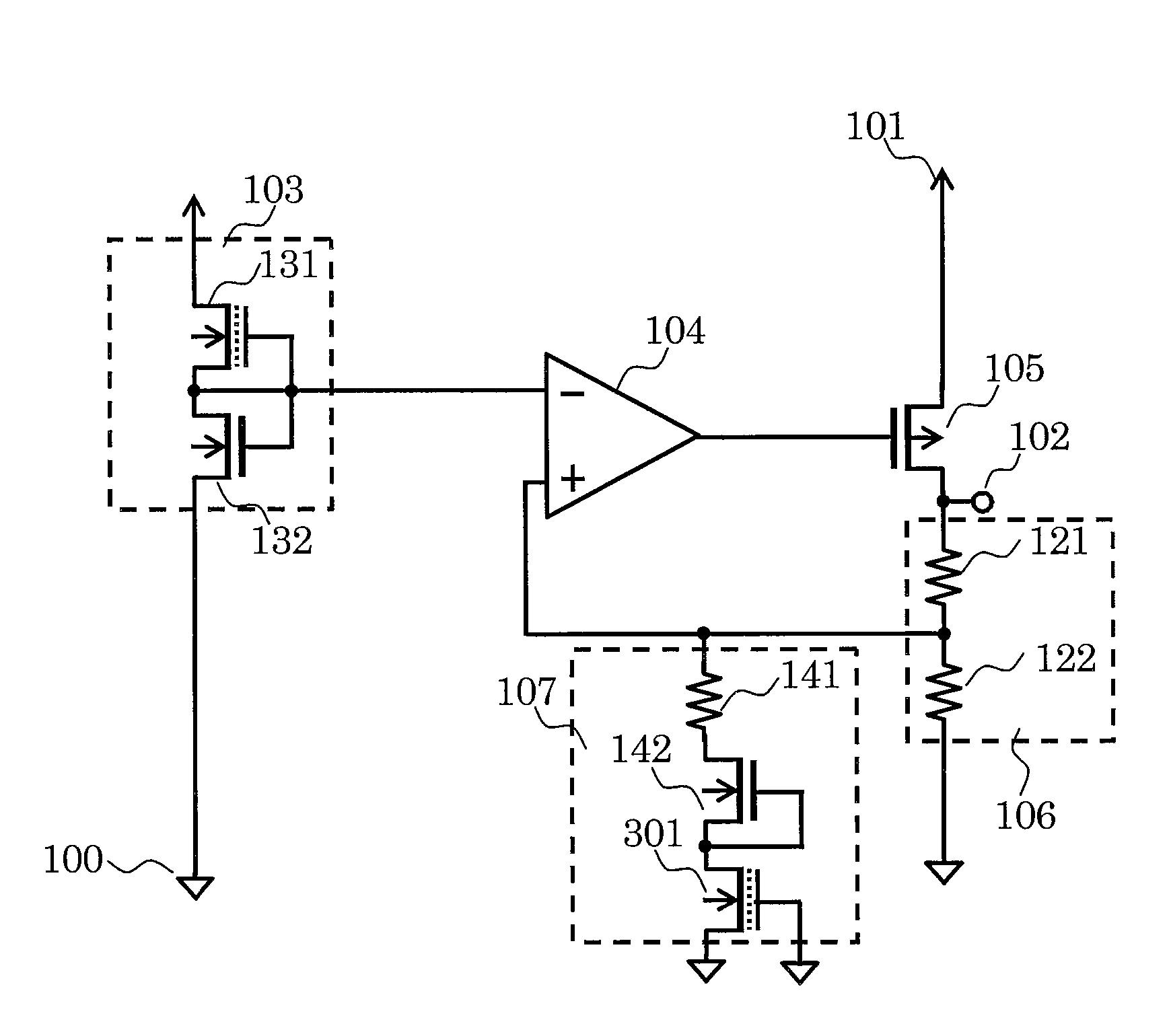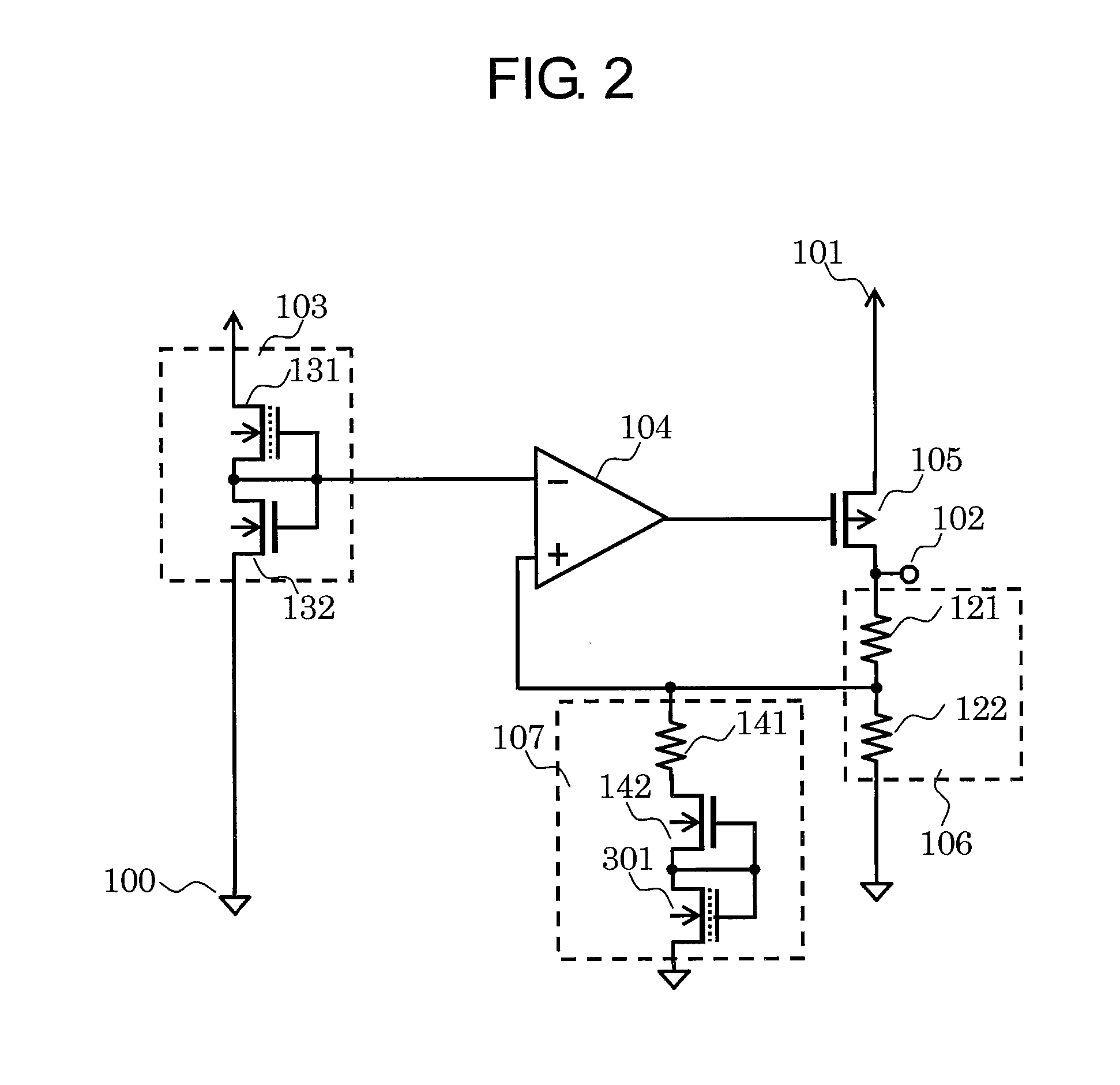Voltage regulator
- Summary
- Abstract
- Description
- Claims
- Application Information
AI Technical Summary
Benefits of technology
Problems solved by technology
Method used
Image
Examples
first embodiment
[0021]FIG. 1 is a circuit diagram illustrating a voltage regulator according to a first embodiment of the present invention. The voltage regulator of the first embodiment includes a reference voltage circuit 103, a differential amplifier circuit 104, an output transistor 105, a voltage divider circuit 106, a leakage current correction circuit 107, a ground terminal 100, a power supply terminal 101, and an output terminal 102. The voltage divider circuit 106 includes resistors 121 and 122. The leakage current correction circuit 107 includes a resistor 141 and an NMOS transistor 142. The reference voltage circuit 103 includes a depletion type NMOS transistor 131 and an NMOS transistor 132.
[0022]The connections are now described. The depletion type NMOS transistor 131 has a gate and a source both connected to a gate and a drain of the NMOS transistor 132 and an inverting input terminal of the differential amplifier circuit 104, and a drain connected to the power supply terminal 101. Th...
second embodiment
[0028]FIG. 2 is a circuit diagram illustrating a voltage regulator according to a second embodiment of the present invention. FIG. 2 differs from FIG. 1 in that the leakage current correction circuit 107 includes a depletion type NMOS transistor 301. The depletion type NMOS transistor 301 has a drain and a gate both connected to the gate and the source of the NMOS transistor 142, and a source connected to the ground terminal 100.
[0029]Next, the operations of the voltage regulator of the second embodiment are described. Because the gate and the source of the NMOS transistor 142 are connected to each other, the leakage current correction circuit 107 can cause the off leakage current to flow at high temperature, to thereby decrease the feedback voltage VFB. Due to the presence of the NMOS transistor 142, the depletion type NMOS transistor 301 does not cause a current to flow at normal temperature, but causes a junction leakage current only at high temperature. By using elements which h...
third embodiment
[0032]FIG. 3 is a circuit diagram illustrating a voltage regulator according to a third embodiment of the present invention. FIG. 3 differs from FIG. 2 in that the gate of the depletion type NMOS transistor 301 is connected to the ground terminal 100.
[0033]Next, the operations of the voltage regulator of the third embodiment are described. Because the gate and the source of the NMOS transistor 142 are connected to each other, the leakage current correction circuit 107 can cause the off leakage current to flow at high temperature, to thereby decrease the feedback voltage VFB. Due to the presence of the NMOS transistor 142, the depletion type NMOS transistor 301 does not cause a current to flow at normal temperature, but causes a junction leakage current only at high temperature. Therefore, no current flows at normal temperature even when the gate of the depletion type NMOS transistor 301 is connected to the ground terminal. The junction leakage current at high temperature is the same...
PUM
 Login to View More
Login to View More Abstract
Description
Claims
Application Information
 Login to View More
Login to View More - R&D
- Intellectual Property
- Life Sciences
- Materials
- Tech Scout
- Unparalleled Data Quality
- Higher Quality Content
- 60% Fewer Hallucinations
Browse by: Latest US Patents, China's latest patents, Technical Efficacy Thesaurus, Application Domain, Technology Topic, Popular Technical Reports.
© 2025 PatSnap. All rights reserved.Legal|Privacy policy|Modern Slavery Act Transparency Statement|Sitemap|About US| Contact US: help@patsnap.com



